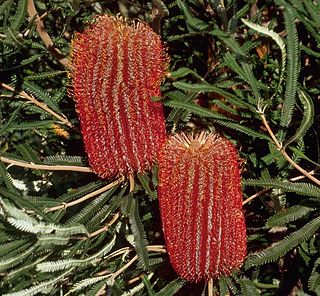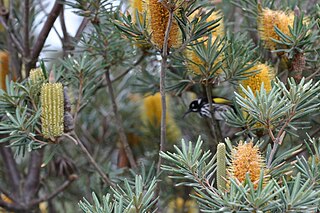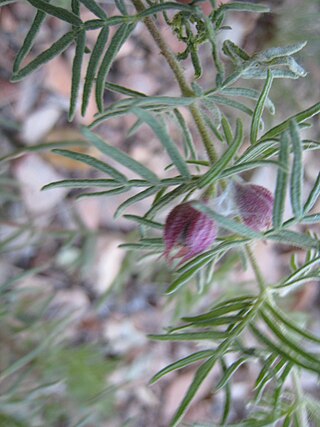
Banksia coccinea, commonly known as the scarlet banksia, waratah banksia or Albany banksia, is an erect shrub or small tree in the family Proteaceae. Its distribution in the wild is along the south west coast of Western Australia, from Denmark to the Stokes National Park, and north to the Stirling Range, growing on white or grey sand in shrubland, heath or open woodland. Reaching up to 8 m (26 ft) in height, it is a single-stemmed plant that has oblong leaves, which are 3–9 cm (1.2–3.5 in) long and 2–7 cm (0.8–2.8 in) wide. The prominent red and white flower spikes appear mainly in the spring. As they age they develop small follicles that store seeds until opened by fire. Though widely occurring, it is highly sensitive to dieback and large populations of plants have succumbed to the disease.

Conospermum is a genus of about 50 species in the family Proteaceae that are endemic to Australia. Members of the genus are known as smokebushes - from a distance, their wispy heads of blue or grey flowers resemble puffs of smoke. They have an unusual pollination method that sometimes leads to the death of visiting insects. They are found in all Australian states, though most occur only in Western Australia. Smokebushes are rarely cultivated, though the flowers of several Western Australian species are harvested for the cut flower industry.

Banksia brownii, commonly known as feather-leaved banksia or Brown's banksia, is a species of shrub that grows in southwest Western Australia. A plant with fine feathery leaves and large red-brown flower spikes, it usually grows as an upright bush around two metres (7 ft) high, but can also occur as a small tree or a low spreading shrub. First collected in 1829 and published the following year, it is placed in Banksiasubgenus Banksia, section Oncostylis, series Spicigerae. There are two genetically distinct forms.

Banksia menziesii, commonly known as firewood banksia, is a species of flowering plant in the genus Banksia. It is a gnarled tree up to 10 m (33 ft) tall, or a lower spreading 1–3 m (3.3–9.8 ft) shrub in the more northern parts of its range. The serrated leaves are dull green with new growth a paler grey green. The prominent autumn and winter inflorescences are often two-coloured red or pink and yellow, and their colour has given rise to more unusual common names such as port wine banksia and strawberry banksia. Yellow blooms are rarely seen.

Banksia marginata, commonly known as the silver banksia, is a species of tree or woody shrub in the plant genus Banksia found throughout much of southeastern Australia. It ranges from the Eyre Peninsula in South Australia to north of Armidale, New South Wales, and across Tasmania and the islands of Bass Strait. It grows in various habitats, including Eucalyptus forest, scrub, heathland and moorland. Banksia marginata varies widely in habit, ranging from a 20-centimetre (7.9 in) shrub to a 12-metre (40 ft) tree. The narrow leaves are linear and the yellow inflorescences occur from late summer to early winter. The flower spikes fade to brown and then grey and develop woody follicles bearing the winged seeds. Originally described by Antonio José Cavanilles in 1800, further collections of B. marginata were designated as several separate species by Robert Brown in 1810. However, all were reclassified as a single species by George Bentham in 1870. No distinct subspecies have been recognised by Banksia expert Alex George, who nonetheless concedes that further work is needed.

Banksia speciosa, commonly known as the showy banksia, is a species of large shrub or small tree in the family Proteaceae. It is found on the south coast of Western Australia between Hopetoun (33°57′ S) and the Great Australian Bight, growing on white or grey sand in shrubland. Reaching up to 8 m (26 ft) in height, it is a single-stemmed plant that has thin leaves with prominent triangular "teeth" along each margin, which are 20–45 cm (7.9–17.7 in) long and 2–4 cm (0.8–1.6 in) wide. The prominent cream-yellow flower spikes known as inflorescences appear throughout the year. As they age they develop up to 20 follicles each that store seeds until opened by fire. Though widely occurring, the species is highly sensitive to dieback and large populations of plants have succumbed to the disease.

Banksia telmatiaea, commonly known as swamp fox banksia or rarely marsh banksia, is a shrub that grows in marshes and swamps along the lower west coast of Australia. It grows as an upright bush up to 2 metres tall, with narrow leaves and a pale brown flower spike, which can produce profuse quantities of nectar. First collected in the 1840s, it was not published as a separate species until 1981; as with several other similar species it was previously included in B. sphaerocarpa.

Banksia verticillata, commonly known as granite banksia or Albany banksia, is a species of shrub or (rarely) tree of the genus Banksia in the family Proteaceae. It is native to the southwest of Western Australia and can reach up to 3 m (10 ft) in height. It can grow taller to 5 m (16 ft) in sheltered areas, and much smaller in more exposed areas. This species has elliptic green leaves and large, bright golden yellow inflorescences or flower spikes, appearing in summer and autumn. The New Holland honeyeater is the most prominent pollinator, although several other species of honeyeater, as well as bees, visit the flower spikes.

Hoya australis, commonly known as the waxvine or common waxflower, is one of the species in the genus Hoya. It is a vine found on rainforest margins and rocky areas, and occurs in eastern and northern Australia, from Western Australia, through the Northern Territory and coastal Queensland from Cape York to northern New South Wales. It is a popular garden plant, noted for its fragrant flowers.

Aphanopetalum is a genus of twining shrubs or vines in the family Aphanopetalaceae which are endemic to Australia.

Althenia is a genus of aquatic plants of the family Potamogetonaceae. This has long been a group of two species in the Mediterranean Europe and South Africa, but in 2016 was revised to include an Australasian relative, Lepilaena.

Pouteria australis, also known by the synonym Planchonella australis, is a medium to tall rainforest tree of the family Sapotaceae native to Queensland and New South Wales, Australia. It is known by the common name black apple, wild plum, yellow buttonwood, black plum and yellow bulletwood.

Flindersia australis, commonly known as crow's ash, flindosy or Australian teak, is a species of tree that is endemic to north-eastern Australia. It has pinnate leaves with between five and thirteen egg-shaped to elliptical leaflets, white to cream-coloured flowers arranged in panicles on the ends of branchlets and followed by woody capsules studded with short, rough points and containing winged seeds.

Thomasia macrocarpa, commonly known as large-fruited thomasia, is a shrub that is endemic to the southwest of Western Australia.

Thryptomene australis, commonly known as hook-leaf thryptomene, is a species of flowering plant in the family Myrtaceae and is endemic to the south-west of Western Australia. It is an erect, bushy and spreading shrub with upward-pointing leaves with the tip curving outwards, and flowers with white petals arranged spike-like near the ends of the branchlets.

Conospermum huegelii, commonly known as the slender smokebush, is a plant endemic to Western Australia.

Xanthorrhoea gracilis, commonly known as the graceful grasstree, grassboy or mimidi, is a species of grasstree of the genus Xanthorrhoea native to Western Australia.

Boronia lanuginosa is a plant in the citrus family Rutaceae and is endemic to northern Australia. It is a shrub with woolly pinnate leaves.

Macarthuria is a genus of dicotyledonous plants belonging to the family Macarthuriaceae, and consists of about 9 species which are endemic to Australia.

Macarthuriaceae is a family of plants in the order Caryophyllales and consists of a single genus, Macarthuria.






















